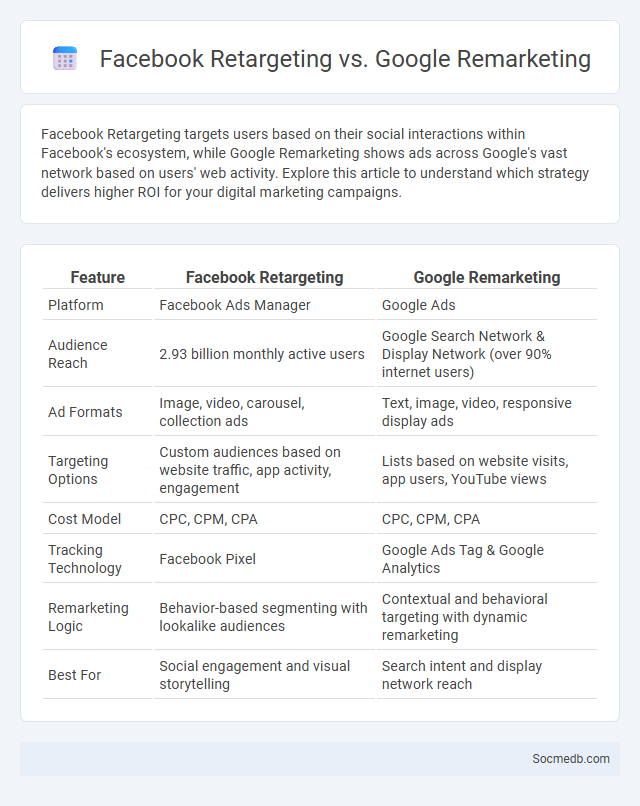
Photo illustration: Facebook Retargeting vs Google Remarketing
Facebook Retargeting targets users based on their social interactions within Facebook's ecosystem, while Google Remarketing shows ads across Google's vast network based on users' web activity. Explore this article to understand which strategy delivers higher ROI for your digital marketing campaigns.
Table of Comparison
| Feature | Facebook Retargeting | Google Remarketing |
|---|---|---|
| Platform | Facebook Ads Manager | Google Ads |
| Audience Reach | 2.93 billion monthly active users | Google Search Network & Display Network (over 90% internet users) |
| Ad Formats | Image, video, carousel, collection ads | Text, image, video, responsive display ads |
| Targeting Options | Custom audiences based on website traffic, app activity, engagement | Lists based on website visits, app users, YouTube views |
| Cost Model | CPC, CPM, CPA | CPC, CPM, CPA |
| Tracking Technology | Facebook Pixel | Google Ads Tag & Google Analytics |
| Remarketing Logic | Behavior-based segmenting with lookalike audiences | Contextual and behavioral targeting with dynamic remarketing |
| Best For | Social engagement and visual storytelling | Search intent and display network reach |
Introduction to Retargeting and Remarketing
Retargeting and remarketing are powerful digital marketing strategies designed to re-engage users who have previously interacted with a brand's website or social media content. By using cookies and tracking pixels, these techniques deliver personalized ads to potential customers, significantly increasing conversion rates. Social media platforms like Facebook, Instagram, and LinkedIn offer advanced retargeting tools that enable businesses to target specific audience segments based on their browsing behavior and engagement history.
What is Facebook Retargeting?
Facebook Retargeting is a powerful advertising strategy that targets users who have previously interacted with Your website or Facebook content, increasing the chances of conversion. By using pixel tracking and custom audiences, it allows you to serve personalized ads to these visitors based on their past behavior. This method enhances engagement and boosts return on ad spend by reconnecting with potential customers already interested in Your brand.
What is Google Remarketing?
Google Remarketing is a digital marketing strategy that targets users who have previously visited a website by displaying tailored ads across the Google Display Network and Google Search. This technique increases conversion rates by reminding potential customers of products or services they showed interest in, using cookies to track user behavior. Businesses leveraging Google Remarketing can effectively boost brand visibility, enhance customer engagement, and improve return on investment (ROI) through personalized ad campaigns.
Retargeting vs Remarketing: Key Differences
Retargeting primarily targets users who have previously interacted with a brand through ads using cookies and pixel tracking to show personalized ads across platforms. Remarketing focuses on re-engaging customers through email lists or CRM data to deliver tailored messages and offers directly to their inboxes. Both strategies aim to increase conversion rates but utilize different channels and data sources for audience segmentation.
Facebook Retargeting: Features and Benefits
Facebook Retargeting leverages user data to deliver personalized ads, increasing conversion rates by targeting audiences who have previously interacted with your website or app. Key features include Custom Audiences, Dynamic Ads, and Lookalike Audiences, enabling precise segmentation and scalable reach. Benefits include higher return on ad spend (ROAS), improved brand recall, and enhanced customer engagement through tailored messaging.
Google Remarketing: Features and Benefits
Google Remarketing leverages user behavior data to display targeted ads across websites, increasing your brand visibility and conversion rates. This feature allows you to re-engage past visitors by showing personalized ads based on their previous interactions, improving ad relevance and click-through rates. Your marketing campaigns benefit from cost-effective ad spend and enhanced customer retention through precise audience segmentation and real-time performance tracking.
Audience Targeting Capabilities: Facebook vs Google
Facebook offers advanced audience targeting capabilities by leveraging extensive user data, including demographics, interests, behaviors, and social connections, enabling advertisers to create highly specific segments. Google targets audiences primarily through search intent and browsing behavior, using keywords, location data, and past interactions across its ecosystem, including YouTube and Google Display Network. While Facebook excels at interest-based and social graph targeting, Google provides strong intent-driven and contextual targeting for reaching users actively searching or consuming relevant content.
Cost Comparison: Facebook Retargeting vs Google Remarketing
Facebook retargeting generally offers lower cost-per-click (CPC) rates compared to Google remarketing, making it a budget-friendly option for advertisers seeking high engagement. Google remarketing, on the other hand, provides access to a vast network through the Google Display Network, often resulting in higher conversion rates despite slightly increased costs. Understanding these cost dynamics helps you allocate your marketing budget effectively for maximum ROI.
Choosing the Right Platform for Your Business
Selecting the ideal social media platform for your business depends on understanding your target audience's demographics and online behaviors. You should analyze engagement rates, content formats, and advertising options across platforms like Facebook, Instagram, LinkedIn, and TikTok to maximize reach and ROI. Tailoring your strategy to the strengths of each platform ensures effective brand visibility and customer interaction.
Conclusion: Which Retargeting Strategy is Best?
The best retargeting strategy on social media depends on audience behavior and campaign goals, with dynamic retargeting proving highly effective for e-commerce by showing personalized product ads. Sequential retargeting enhances engagement by delivering tailored messages based on user interaction stages, increasing conversion rates. Combining these approaches with precise audience segmentation optimizes ad spend and drives higher ROI.
 socmedb.com
socmedb.com